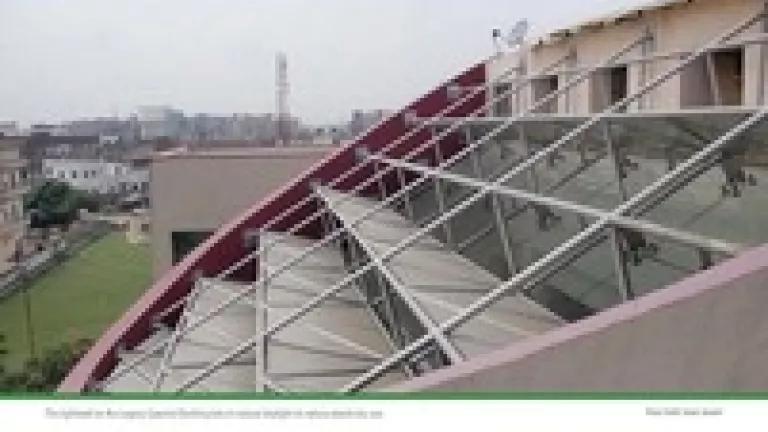New Case Study - Build Smart from the Start: Making the business case for energy-saving construction in India

India is suffering from severe power outages this month. Power plants are running out coal and citizens are protesting in the street as their livelihoods are threatened. Acute power shortages are plaguing the capital, New Delhi, as well as several northern and southern states. To deal with this crisis and provide energy solutions, the Indian government recently announced that the Energy Conservation Building Code (ECBC) will become mandatory for all states.
As India progresses toward mandatory efficiency standards, a new NRDC-ASCI case study unequivocally answers the question most-asked by developers: can you prove that energy efficiency actually saves money in the context of Indian buildings? Our new case study, “Building Smart from the Start: Spotlight on Energy-Saving Commercial Office Building in Noida, India” shows that energy efficiency is good for business and saves costs and energy.
Today, at the Asian Development Bank’s (ADB) 9th Asia Clean Energy Forum in Manila, our team released the case study, supported by the Shakti Sustainable Energy Foundation, showing how an everyday commercial office building in Noida, near New Delhi, is saving money and energy with a payback period of 3.3 years.
Professor Rajkiran Bilolikar from the Administrative Staff College of India (ASCI), Hyderabad, who released the analysis said, “Indian states have an incredible opportunity to construct more efficient buildings today. By dramatically reducing energy demand through building codes and increased participation in ratings programs, states can avoid costly retrofits down the road and lock in energy savings now for decades to come. Incorporating effective compliance mechanisms is key to ensuring codes are successfully establishing at least the minimum efficiency of buildings.”
The case study’s robust analysis of the Noida green office aims to drive the private sector to construct more efficient buildings from the start in India’s rapidly growing cities. This building now occupied by AECOM makes an extraordinary business case for energy efficiency – reaping energy savings for the life of the building through measures that paid for themselves within the first three and a half years. The building shows us that greener, energy-saving buildings are practical and profitable in India’s rapidly transforming building market and provides replicable practices to lock in cost and energy savings.
Constructed in 2007, Legacy Spectral Services (now acquired by AECOM) focused on energy efficiency from the start through the building design—with energy efficiency at its core. The building received the Leadership in Energy Efficiency Design (LEED) Platinum certificate once completed. The high performance efficiency measures built include energy saving heating, an energy management system, lighting and use of natural lighting, and a ventilation and air-conditioning (HVAC) system. Highlights of the case study are:
- Seven years after the energy efficiency investments have paid for themselves, the company is saving a minimum of Rs 10.71 lakhs ($18,000) in annual energy bills every year since.
- The additional costs of the energy efficiency investments were Rs. 36.3 lakh ($88,000 as per 2007 exchange rates) with a payback of three and a half years.
- Estimates during the construction of the building predicted that the design case would consume 38.6% less energy than the base case. Actual building operations post-construction show that in the first year, the building actually used far less energy that predicted with 50.2% less energy than the base case.
- The actual payback period examined through utility bills from 2007-08 to 2012-13 was 3.3 years; The modelled payback period showed 3.1 years with an increasing tariff and 3.4 years with a fixed tariff. The actual payback period aligns closely to the modelled payback period, demonstrating the real world accuracy and predictability of energy modelling results for new buildings.
As the participants at the Asia Clean Energy Forum this week are making clear, linkages between the public and private sector are vital to transition countries like India to a clean energy economy. As local and state governments continue to push the bottom of the market up with minimum efficiency codes and other policies, the private sector can help lead the top of the market to build smart.
Leading states across India are already taking significant steps to accelerate energy efficiency. The Andhra region recently enacted a comprehensive energy efficiency building code and implementation framework that will become effective in August. Minimal code compliance by commercial buildings in the Andhra region translates into a huge savings of 86 terawatt hours of cumulative energy saved by 2030, enough to power as many as 8.9 million Indian households per year over the next 17 years based on the current level of annual energy consumption.
But much remains to be done to energize the market and increase leadership among states. The Noida green commercial office building for new construction, like the NRDC-ASCI case study of Godrej Bhavan office building in Mumbai offers a clear blueprint for companies that want to construct office buildings that are more efficient from the start.
“If we can change the way you think about building, maybe what you build will change the world,” said Dr. Prem C. Jain, Founder, Legacy Spectral Services, on his motivations for building the Noida green building.
Energy efficiency is a key solution to solving the chronic power outages, proving energy access to all, and solving global climate change. India’s continued economic development depends on providing more affordable, clean and reliable energy and moving away from fossil fuels. In addition to reducing dependence on energy imports and increasing energy security, shifting the market to achieve higher levels of energy efficiency offers an incredible payback for India as a whole.
Co-authored by Nehmat Kaur, NRDC India Representative
